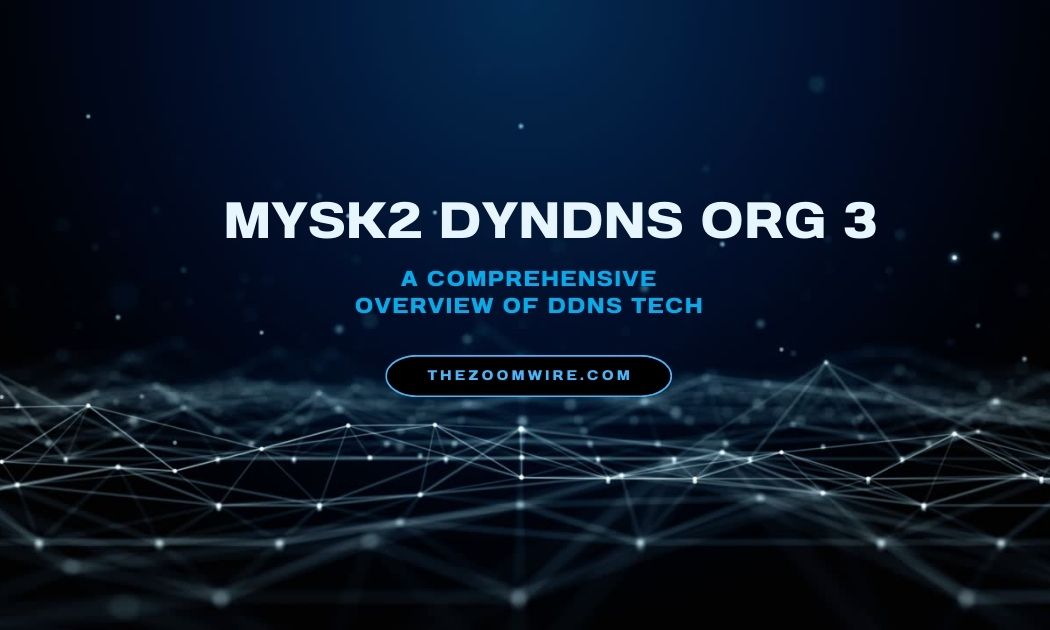Mysk2.dyndns is a domain-based service that uses Dynamic DNS (or DDNS) technology. It enables users to remotely access devices on their home network via a consistent domain name, even when their IP address changes. Mysk2 Dyndns Org 3 permits seamless remote access for personal and professional use, which improves control of network configurations.
Dynamic DNS make easy to access the remote devices by linking domain names to changing IP addresses. This is particularly beneficial for home setup automation or remote file access, as it ensures a reliable connection without the need for constant IP address updates.
What is DDNS?
Dynamic DNS or DDNS is the technology automatically updating DNS records whenever the IP address changes. In other words, while the traditional DNS translates static domain names like www.google.com to IP addresses, DDNS helps maintain a constant hostname even for those who have dynamic IP addresses.
Mysk2 Dyndns Org 3 makes use of the system in tracking changing IPs, and they map them into a consistent hostname. This hence makes home servers, security cameras, or even other remote devices pretty much easier to access, since instead of remembering ever-changing IP addresses, users type the same domain name and get connected.
How Does It Work?
The Mysk2 Dyndns Org 3 system continuously tracks your network’s IP address. When your Internet Service Provider assigns a new IP, which is common for non-business connections, the DDNS client installed on your router or computer automatically updates the domain name in real time.
For example, your home server might initially be on IP address 123.45.67.89 but may then be resolved after a couple of hours or days to 98.76.54.32. Unless otherwise implemented, this will require manual adjustments to incorporate the new IP address of that server. With DDNS however, the service seamlessly associates the new IP with your static domain, mysk2.dyndns.org.
How to Configure
mysk2 dyndns org 3 is split into three major steps:
- Sign up with a DDNS service provider: DynDNS or No-IP is one such service provider. You would need to register on the Mysk2 Dyndns portal as the succeeding step
- Install the DDNS client: Most modern routers come with DDNS support. Enter your credentials and domain name into the DDNS settings in the router’s configuration page.
- Configure your network: Set up all your network devices, including your router and firewall, to enable remote access. Implement Port-Forwarding if you require access to particular devices.
After doing the above step, you will be able to connect to your gadgets over the internet using your mysk2 dyndns org 3 domain name.
Features of the Idea
mysk2 dyndns org 3 in the arena of Dynamic DNS has these key features-
- Real-time update:IP address changes are updated instantly, ensuring the connection is never lost.
- Easy: Once setup, the service is pretty non-intrusive and smooth.
- Compliance: This system is compatible with any router, home automation setup, and even IP cameras.
- Low or free tier: Most of the DDNS services are either free or feature affordable plans, so it can be used by casual users.
- Flexibility: Despite those reasons, the flexibility that DDNS systems such as mysk2 dyndns embrace include adaptation to various scenarios ranging from personal use at home to management of remote office systems.
Router Configuration
For effective functioning of mysk2 dyndns, a thorough configuration and assessment of the router is very important. DDNS setting is usually seen in most of the routers.To configure, do the following:
- Access the web settings of the router(usually at an address like 192.168.1.1).
- Find DDNS under network settings.
- Select the mysk2 dyndns service provider .
- Enter in your name and domain name.
- Save the settings.
Afterward, your router will automatically handle any IP changes, ensuring you always have the same domain name to remotely access your router.
Installation of the DDNS Client
If devices do not come with their DDNS support in built, which is true for devices in some older routers or even specific hardware, you would have to install a dedicated DDNS client.
Several third-party tools are available that can be set up on your computer or server. The client monitors IP changes and updates the mysk2 dyndns service accordingly.
Example: Suppose you want to access your media server at home remotely. You can set up a DDNS client on your server to automatically update your Mysk2 Dyndns domain, allowing you to view your required content around the world.
Advantages and Disadvantages of Dynamic DNS (DDNS)
Advantages:
- Makes Remote Access More Convenient: Regular headache of changing the IP frequently is resolved.
- Very Affordable: Most are free, or costs are very negligible.
- Very Highly Customizable: Works well with many network devices as well as applications
Cons:
- Security Vulnerabilities: The system is designed in a way that could allow unauthorised access if adequate security measures aren’t implemented.
- ISP-Based Issues: Many ISPs change their IP addresses so rapidly that this problem frequently occurs with DDNS.
Why it’s Great for Remote Access
The primary benefit of Mysk2 Dyndns is its simplicity in granting remote access to devices. Whether you’re connecting to a home computer, NAS, or smart devices, DDNS offers a reliable and stable solution for seamless accessibility. It proves to be exceptionally helpful in a business case of a tech enthusiast to access your devices while not being at home.
Test and Troubleshooting
After configuring Mysk2 Dyndns, it is time to test the configuration:
- Access your domain name from a remote location, for instance mysk2.dyndns.org
- Test out the port forwarding feature for cameras or the servers
- Recheck the DDNS operation and the IP verification factors
- If it isn’t, try modifying your firewall settings and/or asking your ISP if they have any IP address problems.
Security Factors and Long-term Reliability
It allows access from an external network, so securing your configuration is very important. Consider adopting the following best practices:
- Implementing strong passwords, ensuring that passwords are updated regularly.
- Tuning up encryption (or SSL) for all connections.
- Enabling two-factor authentication where supported.
- Regularly maintain your DDNS client, thus achieving long-term reliability, preventing downtime.
Accessibility in Android and iOS
The mysk2 dyndns.org 3 service provides mobile applications for Android as well as iOS. This allows users to manage and monitor their domains from remote locations, enhancing accessibility and convenience.Updating IP addresses to monitor network traffic, these apps improve user experience and provide functionality on-the-go.
Conclusion
The Mysk2 Dyndns Org 3 service streamlines the process of connecting to both home and business networks. This is achieved by providing a stable domain name that remains unchanged, despite the frequent shifts in IP addresses experienced by various users. It is user-friendly, highly effective, and capable of sustaining reliable connections, making it essential for those needing internet access to their devices. With appropriate setup and adherence to security protocols, users can manage their access from anywhere in the world through DDNS.



